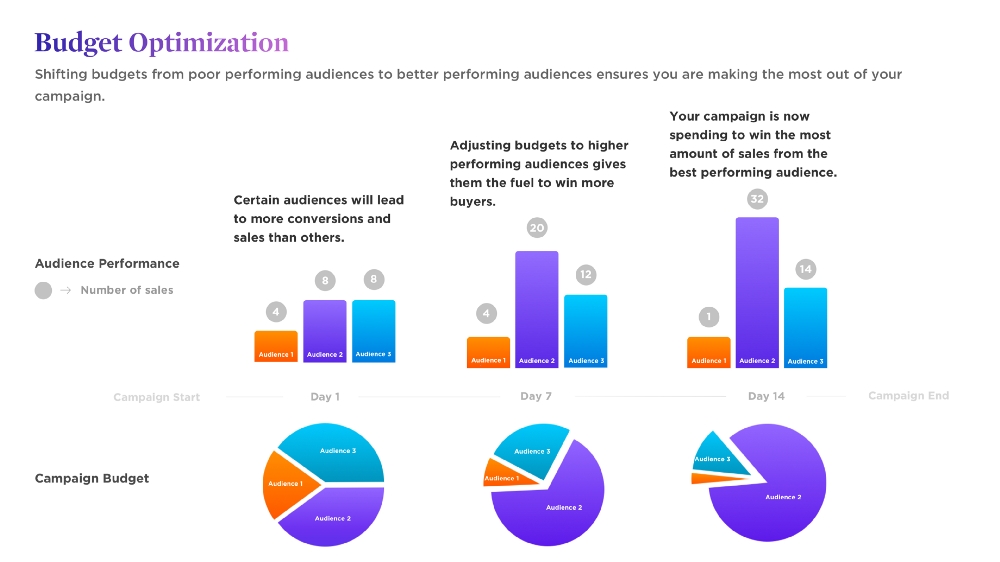What is Budget Optimization?
What is Budget Optimization?
In our previous videos, we outlined the advantages of conversion tracking and A/B testing, two techniques to help you achieve higher returns on your Facebook ad campaigns, especially if you have fixed budgets (most of us do!).
A quick review: Conversion tracking is a way to monitor the amount of money you spend on a Facebook ad campaign and the amount of money you make back.

In this campaign, we spent $294 advertising to the aggregate mailing list. With 28 orders at a cost of $10.31 per order, we made $3,400 worth in orders. Our website purchases reflect that: the return on ad spend is 11.7x. For every dollar that we spent on that particular audience, we got $11.72 back in gross ticket sales.
When you’re using A/B testing in your campaigns, you'll see that not all ad sets, or audiences, have an equal return on ad spend and customer acquisition costs. Some audiences are more profitable to advertise to than others.
Why is this important? If you have a limited budget to spend on Facebook ads, that budget needs to be spent on the ad sets or ad creatives that are driving ticket sales. In other words, that budget needs to go toward serving ads to the fans interested in your event.
Enter budget optimization.
Budget optimization is the process of advertisers setting a budget on an ad campaign that will be optimized to distribute across ad sets to favor the highest performers.
By distributing more of a budget to the highest-performing ad sets, advertisers can maximize the total value of their campaign. Budget optimization works in real time to determine the most effective use of a business’ ad dollars to help lower cost per result and increase return on ad spend.
The basic principle of budget optimization is smart allocation. You’ll spend less on audiences with high customer acquisition costs and more on audiences with low customer acquisition costs, all of which brings in more money.
What does this look like? In the A/B Testing video, we looked at a $100 budget that initially brought in $50 in revenue. By using multiple ad sets and creatives, and by dividing the budget equally between two ad sets, that same budget brought in $300.

Let’s bake budget optimization into that campaign. With a third-party tool like Eventbrite Boost, which uses an automated rule set to move budget from losing audiences to winning audiences, that same $100 dollars would make $450 back.

How did we spend that same $100, on the same audiences, with the same creative, but get $150 more in sales? Instead of evenly splitting that budget between ad set one (interest audience ads) and ad set two (mailing list and traffic audience), we spent $25 less on the first ad set and funneled an extra $25 to the second ad set, the better performing of the two. We made more sales and, because we spent more budget on a more profitable audience, we sold more tickets. And this is budget optimization in practice. It can be done manually or through automated methods (Eventbrite Boost has its own automated budget optimization algorithm).
Campaign budget optimization also saves advertisers time by eliminating the need to manually shift budgets between ad sets.

Eventbrite Boost’s Optimization Engine
Eventbrite Boost’s Optimization Engine automatically analyzes the performance of past campaigns and signals of live campaigns using conversion tracking with A/B testing. The end result maximizes the performance of ad campaigns by learning from data and delivering more desired actions to the advertiser.
Learning from Past Performance
Past ad campaigns indicate the quality of each conversion events. The more you advertise, the more data the Optimization Engine can leverage to learn the optimal signals for your future ad campaigns.
The engine begins by analyzing the performance of all past campaigns. After filtering campaigns by objective and reviewing conversion data, the engine divides the summation of each conversion type by the advertiser’s desire action. This will result in a weight for each conversion event.
Analyzing and Applying Each Data Point
While the campaign is live, the engine multiplies each conversion event by its weight to get the conversion score. For each audience in the campaign, the summation of the conversion score is divided by the amount spent on the audience. This results in the total advertiser value per dollar spent on the audience. This information is used to calculate the remaining budget portion for each audience in the campaign.
By considering the length of your campaign, initial signals indicate the potential of your audiences to convert sales in the future. High quality signals determine spending ratios that are continuously updated and applied to the campaign’s budget.
Conclusion
By using Eventbrite Boost’s Optimization Engine, advertisers can take advantage of more data and automatically apply complex Facebook ad management strategies to their campaigns. With spend increasing every month on Facebook ads, this solution provides a more robust option for advertisers to protect against wasted spend.
Last updated
Was this helpful?